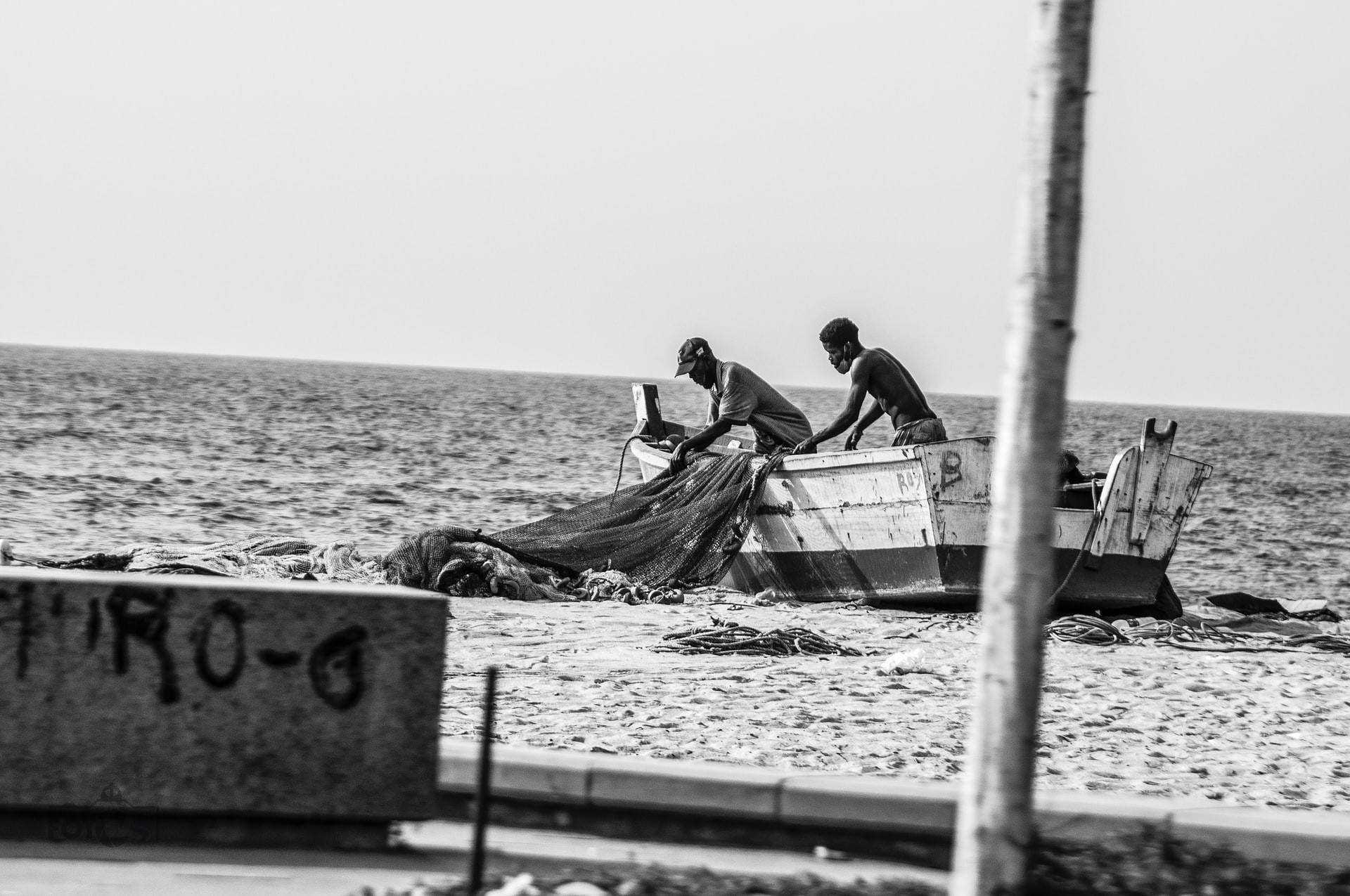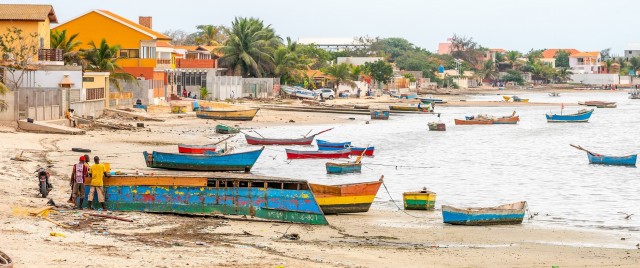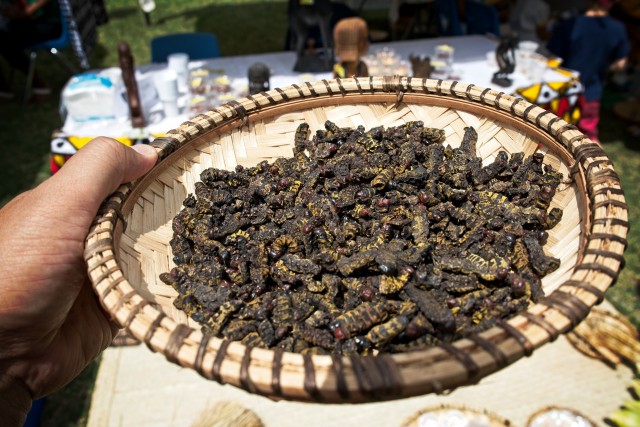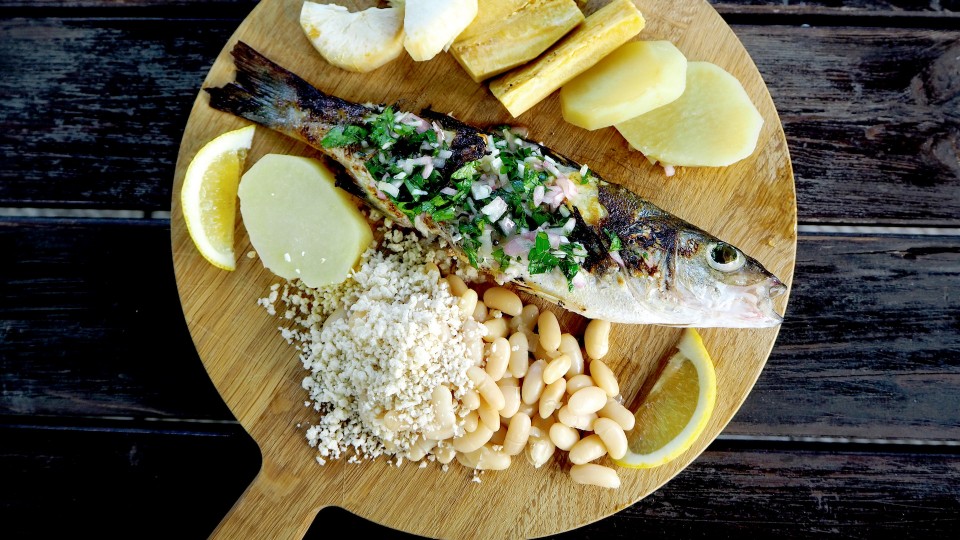Angolan cuisine with Anselmo Silvestre
and his recipe for mufete

Angola
What food did you grow up eating?
“We were colonised by the Portuguese, so we were heavily influenced by Portuguese and Brazilian cuisine [Brazil and Angola were both part of the Portuguese Empire]. Chicken, fish and black beans are all important, and so is bacalhau - dried and salted cod. I grew up with four brothers and a sister, and being the oldest I always used to help out in the kitchen. Not because I had to, but because I wanted to.”
What got you into cooking?
“I never thought about becoming a chef. I was 18 when I moved to Cape Town to study hotel management, but then saw what you could do in the kitchen. I realised that was what I wanted to do. I finished hotel management and then studied culinary arts for a year. I’ve been working as a chef since then.
“There are no chefs in my family. Actually, there were hardly any qualified chefs in Angola when I grew up. There is a culinary school now, but there wasn’t one when I was younger. I hope I can inspire other people to become chefs, too.”
You’re now living and working in South Africa. Do you see many similarities between Angolan and South African cuisine?
“I would say it’s 50/50. They have something called pap (also called ugali) here, which is maize porridge. We have funge, which is similar but made from cassava flour. Both funge and pap are eaten with grilled meat.”
Anselmo also sees differences, however. South African cuisine uses a lot more spices than Angolan, and this influence has its history in colonial South Africa, where the slave trade of the Dutch East India Company brought spices from Bengal, Java and Malaysia. This regional cuisine is known as Cape Dutch or Cape Malay. “Angola doesn’t have that Malay influence - we don’t use spices at all. Portuguese cuisine in general also has way fewer spices than many other cuisines. Another difference is the fact that South Africans put everything on the braai – an open fire grill. Grilling is big in Angola as well, but it’s not as essential as it is in South Africa.”

The Angolan Civil War (1975 – 2002) had a negative effect on the country’s agriculture, despite the fact that the country has very fertile soils and a suitable climate for many crops including coffee, bananas and cassava. “Many people living farther from the coast rely on hunting, as farming isn’t at the level it should be. Buffaloes and antelopes are on the menu, but fish is important in these areas too. It’s freshwater fish rather than the marine fish we get along the coast.”
What produce does the land provide?
“There are many great vegetables, like okra, maize and cassava. Fruits include maboque (green monkey orange), jinguenga (heaven’s fruit), caju (apple from the cashew tree) and fruta pão (breadfruit). Our land is so rich, but we have to learn to utilise it better. It’s improving, but we’re not there yet.

“When it comes to meat and fish - we do import bacalhau from Portugal and get a lot of poultry from overseas, but most meat is farmed locally. There’s one special caterpillar, called catato that I’ve used in cooking too. It’s great with dried mushrooms and garlic! I really think that’s the food of the future, but not many people eat it yet.”

The Dish
Mufete is a typical dish from the capital Luanda, or more specifically from the sandspit called Ilha de Luanda, but it is popular throughout Angola.
"I remember waking up with the smell of grilled fish. Mufete was a weekend breakfast or lunch dish for us. You'd either have the light version, with just the fish and onion salsa, or the full experience with the beans, sweet potato, plantain and cassava. You need the rest of the day to digest it!
"Traditionally you'd eat it at celebrations, weddings... any special event, but nowadays people, especially the islanders [living on Ilha de Luanda] eat it a couple of times per week. I actually don’t mind having mufete every few days either!
“I taught myself how to make it by eating it and watching other people make it. And tasting it, a thousand times. I now have my own way of preparing it and it’s one of my favourite dishes.”
The Ingredients
- Onion salsa
- 1
- small onion, chopped
- a handful
- parsley, chopped
- a splash
- lemon juice
- 1 tbsp
- white wine vinegar
- 1 tbsp
- olive oil
- Mufete
- 1
- whole carapau or tilapia fish
- 2
- medium-sized plantains
- 2/3
- sweet potatoes (or regular potatoes)
- farinha musseque (toasted ground manioc) or breadcrumbs, to garnish
- 2/3
- yams or cassavas
- 1 tsp
- salt
- 180 g
- dried butter beans (or other white beans), soaked for at least 2 hours or overnight
- black pepper, to taste
- 1
- small onion, finely chopped
- sugar, to taste
- 50 ml
- palm oil
- 1
- bay leaf
- 1
- garlic clove, crushed
- juice of 1 lemon
- Onion salsa
- 1
- small onion, chopped
- a handful
- parsley, chopped
- a splash
- lemon juice
- 1 tbsp
- white wine vinegar
- 1 tbsp
- olive oil
- Mufete
- 1
- whole carapau or tilapia fish
- 2
- medium-sized plantains
- 2/3
- sweet potatoes (or regular potatoes)
- farinha musseque (toasted ground manioc) or breadcrumbs, to garnish
- 2/3
- yams or cassavas
- 1 tsp
- salt
- 1 cup
- dried butter beans (or other white beans), soaked for at least 2 hours or overnight
- black pepper, to taste
- 1
- small onion, finely chopped
- sugar, to taste
- 1/4 cup
- palm oil
- 1
- bay leaf
- 1
- garlic clove, crushed
- juice of 1 lemon
The Recipe
Onion salsa
- Begin with theby combining the chopped onion and parsley in a bowl, then add the remaining ingredients with 1 tablespoon hot water and some salt. Mix well and set aside.
Mufete
- Once the beans have soaked, discard the water and place beans and bay leaf in a pot with enough water to cover and boil for 30 minutes. Drain.
- Clean the fish and score the skin on both sides. In a small bowl, mix 1 teaspoon salt, the lemon juice, olive oil and crushed garlic and rub this mixture inside the fish, and into the scores on the skin. Leave to marinate for 15 minutes.
- Peel the sweet (or regular) potatoes, yams (or cassava) and plantains, place in a large pot of salted water and boil for 15 minutes. Once soft, drain and set aside.
- Light a barbecue (or pre-heat grill to medium heat) and place the marinated fish over charcoal fire or under the grill for 3-5 minutes each side, or until just cooked through.
- Fry the onions in the palm oil with the bay leaf until translucent. Add 475ml / 2 cups of water and the beans and simmer for 15 minutes. Adjust the seasoning to taste with salt and sugar.
- Once everything is cooked, assemble fish, sweet potatoes, plantain, and beans on a large plate to share. Garnish the fish with a lemon wedge and sprinkle farinha (or breadcrumbs) over the beans.